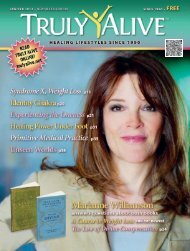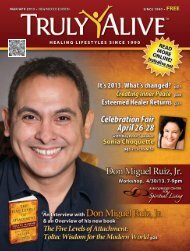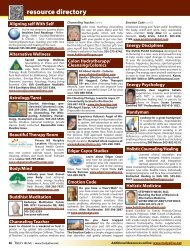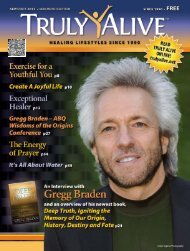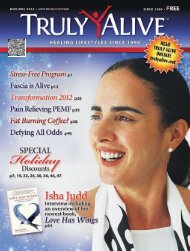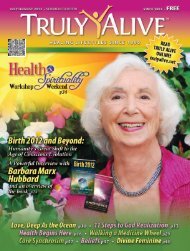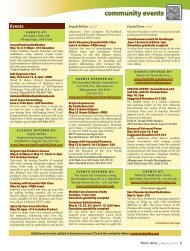Dr. Bruce Lipton - The Honeymoon Effect - Truly Alive Magazine
Dr. Bruce Lipton - The Honeymoon Effect - Truly Alive Magazine
Dr. Bruce Lipton - The Honeymoon Effect - Truly Alive Magazine
You also want an ePaper? Increase the reach of your titles
YUMPU automatically turns print PDFs into web optimized ePapers that Google loves.
“Myofascial <strong>The</strong>rapy has helped me so much that I<br />
wish my mother could have treatment for her low back<br />
pain, but I don’t think she could handle it.” “My daughter<br />
was in the car accident with me, but she is only 5 years old<br />
and I think Myofascial <strong>The</strong>rapy would be difficult for her.”<br />
In the past year, I have had to explain quite a few<br />
times how Myofascial <strong>The</strong>rapy for pain relief can benefit<br />
everyone—young, old, female, male, athletes, couch<br />
potatoes, physically challenged, etc. And that’s good news.<br />
Years ago (when I graduated in 1983<br />
to be exact), we were taught to treat<br />
Myofascial Pain and Dysfunction one<br />
way—use your elbows and thumbs with<br />
a lot of pressure on the muscle, hold for<br />
seven to twenty seconds and sometimes<br />
up to a minute to inactivate the Trigger<br />
Myofascial <strong>The</strong>rapy<br />
One Size Does Not Fit All By Victoria L Magown<br />
...we treat and teach the<br />
importance of working<br />
with the patient at a<br />
level of pressure they can<br />
tolerate...<br />
Point. It was painful for the patient and exhausting for the<br />
therapist. But it did work; only it took a very long time for<br />
the patient to become pain-free.<br />
Since those early years, I have attended two to three<br />
conventions, meetings, seminars and lectures each year<br />
to continue learning and developing a more comfortable<br />
way to treat a person who is already in pain. During these<br />
years, continued research has given us answers about<br />
Trigger Points, muscles and fascia. We now have a clearer<br />
understanding of what we are putting our elbows into<br />
when treat.<br />
Now, we treat and teach the importance of working<br />
with the patient at a level of pressure they can tolerate.<br />
That means, yes, we can treat children, which I have. <strong>The</strong>y<br />
respond quickly to Myofascial <strong>The</strong>rapy since they have<br />
fewer years of opportunity to incur trauma.<br />
And yes, we do treat seniors quite successfully as well.<br />
My latest senior is 80 years old and wants to know when<br />
she can get back to the gym. At the rate she is responding<br />
to Myofascial <strong>The</strong>rapy, she will return soon.<br />
So what exactly do we do? What does a Myofascial<br />
<strong>The</strong>rapy treatment entail? After taking a complete history<br />
of all the trauma your body had experienced since you<br />
were born, we draw your pain pattern and evaluate the<br />
muscles and fascia involved with Range of Motion tests.<br />
This helps identify which muscles and fascia are most<br />
restricted—as those are the ones that have developed<br />
Trigger Points and Fascia Points.<br />
Treatment usually starts in the pelvis and torso to<br />
decrease pain and improve posture. Once posture is<br />
improved and overall pain has decreased, we treat the<br />
extremities if needed A Home Exercise Program is given<br />
so you can keep the release we obtain in treatment and<br />
retrain the fascia and muscles to stay at their full length,<br />
pain free. Only three or four exercises are given; each<br />
involving many muscles, so one can perform only one or<br />
two repetitions, several times throughout<br />
the day and get the full benefit.<br />
Myofascial <strong>The</strong>rapy treatment begins<br />
with broad contact on the tissue, usually<br />
using the flat of the forearm or heel of the<br />
hand. Pressure is applied to the patient’s<br />
tolerance followed by a short push to<br />
lengthen the Superficial Fascia just under the skin. <strong>The</strong><br />
short push is held only 2-5 seconds at a tolerable level.<br />
It is important that the patient not tense up or contract<br />
the fascia and muscles, as this does not facilitate a good<br />
release.<br />
After an area of Superficial Fascia is released, we<br />
specifically treat Fascia Points and Trigger Points using<br />
the elbow or thumbs. We use the same technique of<br />
Pressure, Short Push, holding 2 seconds, all to the<br />
patient’s tolerance level. If an area is quite tender, then<br />
we “Surround the <strong>Dr</strong>agon” which involves treating in a<br />
circle all around the point slowly moving closer to it until<br />
it is released. <strong>The</strong> goal of treatment is to elongate and<br />
lengthen the fascia and muscles to be at their normal full<br />
length, pain free.<br />
Each person who comes to MyoRehab is uniquely<br />
different and it is the Myofascial <strong>The</strong>rapist’s responsibility<br />
to involve the person in the treatment explaining what<br />
they are doing, feeling, etc. It is also the therapist’s<br />
responsibility to determine how much pressure to apply<br />
without the person tensing their fascia and muscles. In<br />
this way, therapist and patient work together to obtain a<br />
good release of Fascia Points and Trigger Points.<br />
“One Size Does Not Fit All”. Call MyoRehab at 505-872-3100<br />
and make an appointment now. Conveniently located at<br />
4263 Montgomery NE, #200, Albuquerque, NM 87109<br />
www.myorehab.net<br />
Read more articles by both Victoria authors L. Magown online: online: www.trulyalive.net<br />
<strong>Truly</strong> <strong>Alive</strong> | September/October 2013 9



